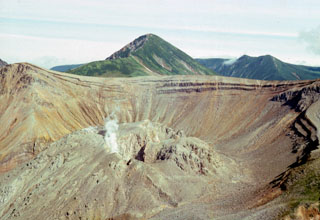Report on Kolokol Group (Russia) — December 1981
Scientific Event Alert Network Bulletin, vol. 6, no. 12 (December 1981)
Managing Editor: Lindsay McClelland.
Kolokol Group (Russia) Weak gas release from the Berg and Trezubetz summit domes
Please cite this report as:
Global Volcanism Program, 1981. Report on Kolokol Group (Russia) (McClelland, L., ed.). Scientific Event Alert Network Bulletin, 6:12. Smithsonian Institution. https://doi.org/10.5479/si.GVP.SEAN198112-290120
Kolokol Group
Russia
46.042°N, 150.083°E; summit elev. 1328 m
All times are local (unless otherwise noted)
Very weak gas emission was occurring from the summits of extrusive domes at both Berg and Trezubetz during the 20 September 1981 flight.
Geological Summary. A group of Holocene volcanoes in central Urup Island is named after its most prominent volcano, Kolokol. Berg and Trezubetz volcanoes, flanking Kolokol on the NW, have breached summit calderas partially filled by lava domes. Trezubetz, whose name means "Trident," has an eroded crater rim with three large peaks when seen at sea from the north. Kolokol is sometimes known as Urup-Fuji because of its symmetrical profile. The crater of Kolokol is not well preserved, but there is no evidence of glacial erosion. Several lava flows originate from Kolokol; one of these extends almost to the Sea of Okhotsk coast; a viscous lava flow armoring the SE flank is probably the most recent. Borzov volcano, the oldest of the group, lies to the SW of Kolokol. Eruptions have been observed since the late-18th century. Berg volcano has been most active, but Trezubetz erupted in 1924.
Information Contacts: G. Steinberg, Sakhalin Complex Institute.

